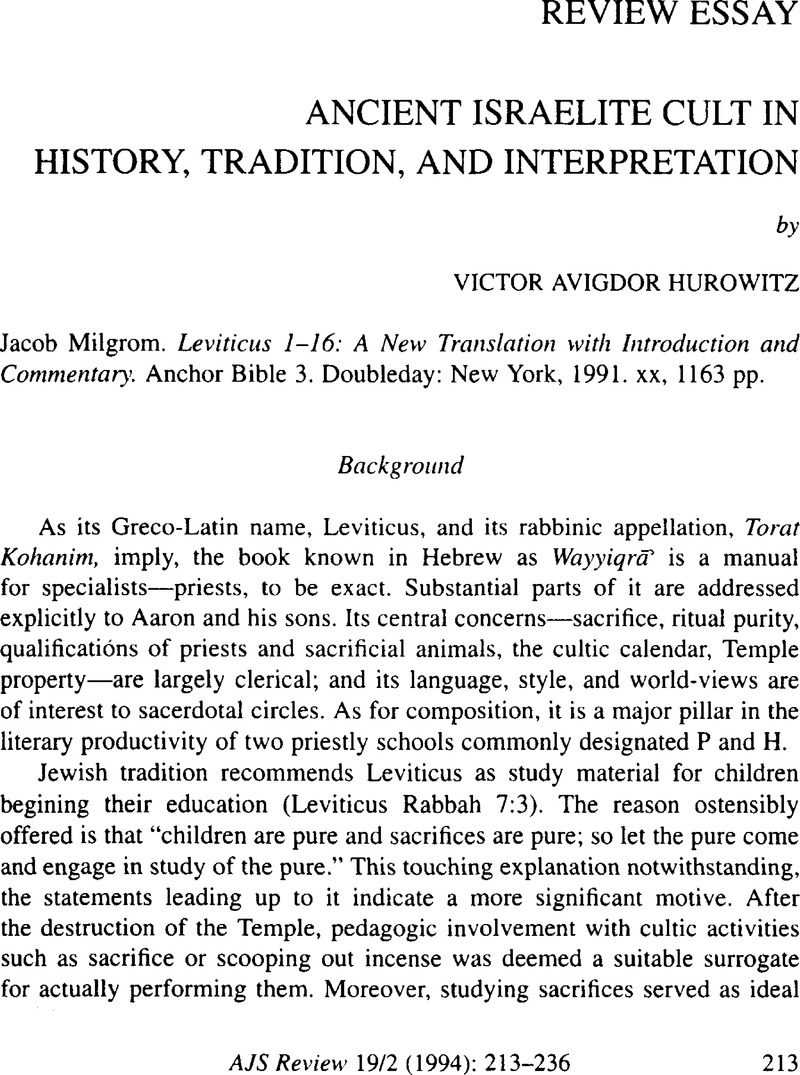No CrossRef data available.
Article contents
Ancient Israelite Cult in History, Tradition, and Interpretation
Published online by Cambridge University Press: 15 October 2009
Abstract

- Type
- Review Essay
- Information
- Copyright
- Copyright © Association for Jewish Studies 1994
References
1. Micklem, N., in The Interpreter's Bible, vol. 2 (Nashville, 1953). p. 4.Google Scholar
2. The commentary of Baruch Levine, another eminent authority on the Book of Leviticus and ancient Israelite cult, is also written to high scholarly standards, but is aimed at a less scholarly and specifically Jewish audience. It is therefore much narrower in scope and far less detailed. It also touches more directly on issues of contemporary Jewish interest. See B. A. Levine, The JPS Torah Commentary: Leviticus (Philadelphia, 1989). Since Levine and Milgrom often disagree, the serious reader will certainly want to refer to both volumes.
3. See Levine, Leviticus, pp. 215–238.Google Scholar
4. See now Knohl, I., The Sanctuary of Silence: A Study of the Priestly Strata in the Pentateuch, [Heb.] (Jerusalem: Magnes, 1992).Google Scholar
5. Driver, S. R., The Book of Leviticus (Leipzig, 1894).Google Scholar
6. , Leviticus, Handbuch zum Alten Testament 4 (Tubingen, 1966).Google Scholar
7. Die Priesterschrift von Exodus 25 bis Leviticus 16: Eine überlieferungsgeschichtliche und literariesche Untersuchung, Forschongen zur Religion und literatur des Alten und Neuen Testaments 71 (Gottingen, 1959).Google Scholar
8. Arnaud, D., Recherches an Pays d'aštata Emar VI. 1–4. Textes sumeriens el accadiens (Paris, 1985–1987).Google Scholar
9. Foxvog, D. A., A Manual of Sacrificial Procedure, in DUMU-E2-DUB-BA-A: Studies in Honor of Sjöberg, Åke W., ed. H., Behrens et al. (Philadelphia, 1989), pp. 167–176.Google Scholar
10. See also p. 789 on Lev. 13:22.
11. Biblical Archaeologist 43 (1980): 241–247.Google Scholar
12. See for now my discussion in Israel Exploration Journal, 1984, pp. 68–69. A more detailed refutation will appear shortly in the Jewish Quarterly Review.Google Scholar
13. See my Some Literary Observations on the Sitti-Marduk Kudurru (BBSt. 6), Zeitschrift fiir Assyriologie 82 (1992): 39–59, esp. p. 40, n. 7.Google Scholar
14. For an additional introverted, seven-limbed text in a cultic context found outside the Pentateuch in 1 Sam. 3:17–18, see my Elis Aduration of Samuel (I Sam. iii 17–18) in Light of a Diviners Protocol From Mari (AEM 1/1,1). Vetus Testamentum 44 (1994).Google Scholar
15. For details, see my contribution to the upcoming J. Milgrom Festschrift
16. See Hurowitz, A., Shnaton 7–8 (1984): 57 n. 18.Google Scholar
17. For a critique of Milgrom's explanation of the Red Heifer, see now Baumgarten, A. I., The Paradox of the Red Heifer, Vetus Testamentum 43 (1993): 442–451/Google Scholar
18. See Horowitz, W. and Hurowitz, V. (A.), Urim and Thummim in Light of a Psephomancy Ritual from Assur (LKA 137), Journal of the Ancient Near Eastern Society 21 (1992): 95–115.Google Scholar
19. See now Starr, I., Queries to the Sungod: Divination and Politics in Sargonid Assyria, State Archives of Assyria IV (Helsinki, 1990).Google Scholar
20. Cf. Starr. Queries to the Sun Cod, pp. xxii–xxvii.Google Scholar
21. Bibliotheca Orientalis 30 (1973): 163 (= Römer, Texte aus der Umwelt des Allen Testament 2:171–175).
22. Biblical Archaeology Review 2 (1976): 3–4, 42.Google Scholar
23. See Malul, M., Vetus Testamentum 37 (1987): 491–92.CrossRefGoogle Scholar
24. Cf. Kramer, S. N., The Sumerians: Their History, Culture and Character (Chicago, 1963), pp. 285–286.Google Scholar


